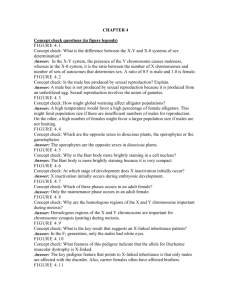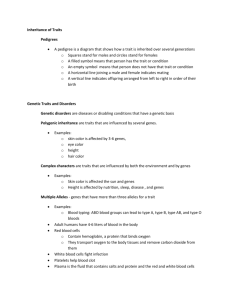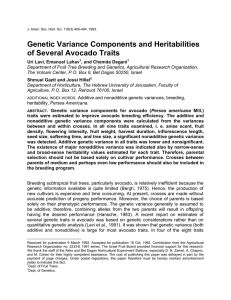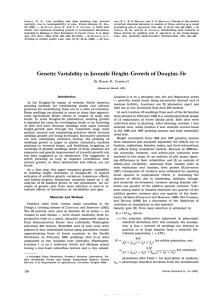A genetic perspective on gender, culture, and mathematics performance Please share
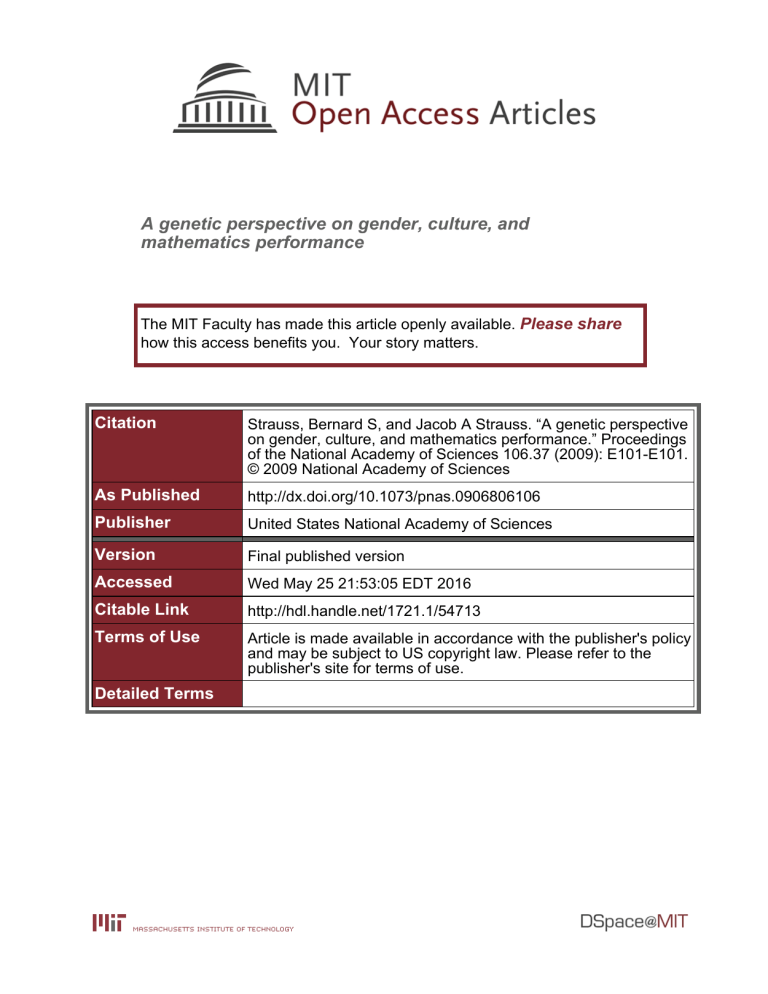
A genetic perspective on gender, culture, and mathematics performance
The MIT Faculty has made this article openly available.
Please share
how this access benefits you. Your story matters.
Citation
As Published
Publisher
Version
Accessed
Citable Link
Terms of Use
Detailed Terms
Strauss, Bernard S, and Jacob A Strauss. “A genetic perspective on gender, culture, and mathematics performance.” Proceedings of the National Academy of Sciences 106.37 (2009): E101-E101.
© 2009 National Academy of Sciences http://dx.doi.org/10.1073/pnas.0906806106
United States National Academy of Sciences
Final published version
Wed May 25 21:53:05 EDT 2016 http://hdl.handle.net/1721.1/54713
Article is made available in accordance with the publisher's policy and may be subject to US copyright law. Please refer to the publisher's site for terms of use.
LETTER
A genetic perspective on gender, culture, and mathematics performance
Both biological and social scientists have recently commented on the supposed greater variability of males in IQ tests and in mathematical achievement (1). Missing from these discussions is any consideration of possible genetic mechanisms that might be involved. To paraphrase Sir Arthur Eddington, ‘‘it is a good rule not to put overmuch confidence in the observational results . . . until they are confirmed by theory.’’ But there is a theory that accounts for the observed results (2, 3).
Given the mechanism of mammalian sex determination and the phenomenon of X inactivation, males will be more variable than females for any traits affected by genes located on the X chromosome. For any number of loci, the male variance is greater than the female by the fraction of loci that are on the X chromosome. If IQ were determined solely by genetic factors, the variance ratio between males and females could take any value between 1 and 2 depending on the proportion of relevant genes found on the X chromosome. The genetic explanation predicts that there should be female mathematicians as talented as any males or female dullards as untalented as any male. All that is required is a sufficiently large sample to permit such individuals to show up. Increased accessibility provides this larger population.
How well do the observed variance ratios for IQ in the UK
(4) and mathematical ability (1) fit these models? All are consistent with the predicted range between 1 and 2. The observed IQ variance ratio falls between 1.07 and 1.17, depending on the component tested (4). In a study on the number of words per day used by males and females (probably measuring something quite different than IQ), the mean was statistically indistinguishable but the male variance was about 1.40
times greater (5). The finding that these ratios are less than the theoretical maximum implies that if genes are involved, not all are on the X chromosome and/or that nongenetic factors play a role; the greater the role of such factors the lower the difference in variance should be.
It is most unlikely that IQ and word usage are related to a single gene but are probably multigenic traits with major environmental inf luences. Studies on the possibly related trait of spatial ability, summarized in a review by David Boles (6) almost three decades ago, effectively eliminated a single major
X-linked locus as responsible. More-recent studies considering a wider range of models have identified several traits affected by both X-linked and autosomal genes and environmental effects (3).
The questions proposed by Hyde and Merz (1) are examples of the ongoing debate about the relative roles of nature and nurture in human life. It should be clear that both are important. It might also be pointed out that the UK study (4) concluded that the difference in IQ scores related to sex was extremely small compared to the differences related to socioeconomic status.
Bernard S. Strauss a,1 and Jacob A. Strauss b a Department of Molecular Genetics and Cell Biology, University of
Chicago, Chicago, IL 60637; and b MIT Computer Science and
Artificial Intelligence Laboratory, Cambridge, MA 02139
1. Hyde JS, Mertz JE (2009) Gender, culture, and mathematics performance.
Proc Natl
Acad Sci USA 106:8801– 8807.
2. Lange K, Sobel E (2006) Variance component models for X-linked QTLs.
Genet Epidemiol 30:380 –383.
3. Pan L, Ober C, Abney M (2007) Heritability estimation of sex-specific effects on human quantitative traits.
Genet Epidemiol 31:338 –347.
4. Strand S, Deary IJ, Smith P (2006) Sex differences in cognitive abilities test scores: A UK national picture.
Br J Educ Psychol 76:463– 480.
5. Mehl MR, Vazire S, Ramirez-Esparza N, Slatcher RB, Pennebaker JW (2007) Are women really more talkative than men?
Science 317:82.
6. Boles DB (1980) X-linkage of spatial ability: A critical review.
Child Dev 51:625– 635.
Author contributions: B.S.S. designed research; J.A.S. performed research; B.S.S. and J.A.S.
analyzed data; and B.S.S. and J.A.S. wrote the paper.
The authors declare no conflict of interest.
1 To whom correspondence should be addressed. E-mail: bs19@uchicago.edu.
www.pnas.org
兾 cgi 兾 doi 兾 10.1073
兾 pnas.0906806106
PNAS 兩 September 15, 2009 兩 vol. 106 兩 no. 37 兩 E101




